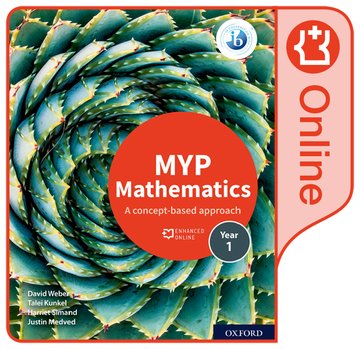MYP Mathematics 1: Enhanced Online Course Book
Build mathematical understanding and conceptual connections
Author David Weber, Author Talei Kunkel, and Author Harriet Simand
Suitable for: MYP Year 1 students
Price: £44.99
+VAT
ISBN:
978-0-19-835620-2
Publication date:
11/10/2018
Digital Licence Key:
336 pages
Dimensions:
210x148mm

Digital Evaluation
Schools can access an online copy of the whole book free of charge for 30 days. At the end of the evaluation period, you can buy printed copies here or through your usual sales consultant or bookseller.
Free Trial
Register your school for a free trial of the digital subscription. For more information contact your local educational consultant.
You can use the basket to:
- pay by credit card
- order on account
- forward to a colleague
Description
Features
- Progress your learners into IB Diploma - fully comprehensive and matched to the MYP Next Chapter curriculum.
- Develop conceptual understanding in the best way for your learners - learn by mathematical unit or by key concept.
- Drive active, critical exploration of mathematical principles - build rounded comprehension framed within the key and related concepts.
- Develop meaningful cross-curricular connections that help learners recognize and manipulate mathematical ideas in other disciplines.
- Support higher level thinking skills through an approach grounded in factual, conceptual and debatable questions.
- Build a solid foundation of practical skills with extensive practice equipping learners to apply skills.
- Fully prepare learners for the MYP eAssessment.
- The online Student Book will be available on Oxford Education Bookshelf until 2028. Access is facilitated via a unique code, which is sent in the mail. The code must be linked to an email address, creating a user account. Access may be transferred once to a new user, once the initial user no longer requires access. You will need to contact your local Educational Consultant to arrange this.
This page was last updated on 01 May 2024 at 04:30 GMT
Table of Contents
Unit 1 Numbers and number systems: Civilizations and human interactions
1.1: Representing numbers
1.2: Place value, expanded form and scientific notation
1.3: Number systems with different bases
1.4: Powers, indices and roots
1.5: Factors, multiples and prime numbers
1.6: Greatest common factor and lowest common multiple
1.7: Factors and divisibility
1.8: Order of operations
1.9: Number systems from different civilizations
Unit 2 Percentages: Inequality and difference
2.1: Different forms of percentages
2.2: Converting fractions and percentages
2.3: Converting decimals and percentages
2.4: Applications of percentages
2.5: Percentage increase and decrease
Unit 3 Algebraic expressions and equations: Patterns in nature
3.1: Patterns in different forms - diagrams, sequences, tables and words
3.2: Simplifying algebraic expressions
3.3: Generalizing mathematical patterns
3.4: Patterns as functions
3.5: Algebraic equations
3.6: Patterns in nature
Unit 4 Geometric constructions: Artistry and creativity
4.1: Rays, line segments and lines
4.2: Classifying, measuring and constructing angles
4.3: Angles formed by intersecting lines and parallel lines with a transversal
4.4: Classification of triangles
4.5: Interior and exterior angles of triangles
Unit 5 Fractions: Human connections
5.1: Fractions in different forms
5.2: Comparing fractions
5.3: Multiplying and dividing fractions
5.4: Adding and subtracting fractions
5.5: Multiple operations with fractions
Unit 6 Data management: Trends in communities
6.1: Types of data
6.2: Representation of data
6.3: Types of graphs
6.4: Comparison of data and showing trends
6.5: Misleading graphs
Unit 7 Perimeter, area and volume: Environmental impacts
7.1: Venn diagrams
7.2: Perimeter and area of triangles, rectangles and compound shapes
7.3: 2D shapes and the volume of corresponding prisms
7.4: Volume of rectangular and triangular prisms
7.5: Surface area of rectangular and triangular prisms
7.6: Relationships between surface area and volume of prisms
© 2024 Oxford University Press. All rights reserved.






